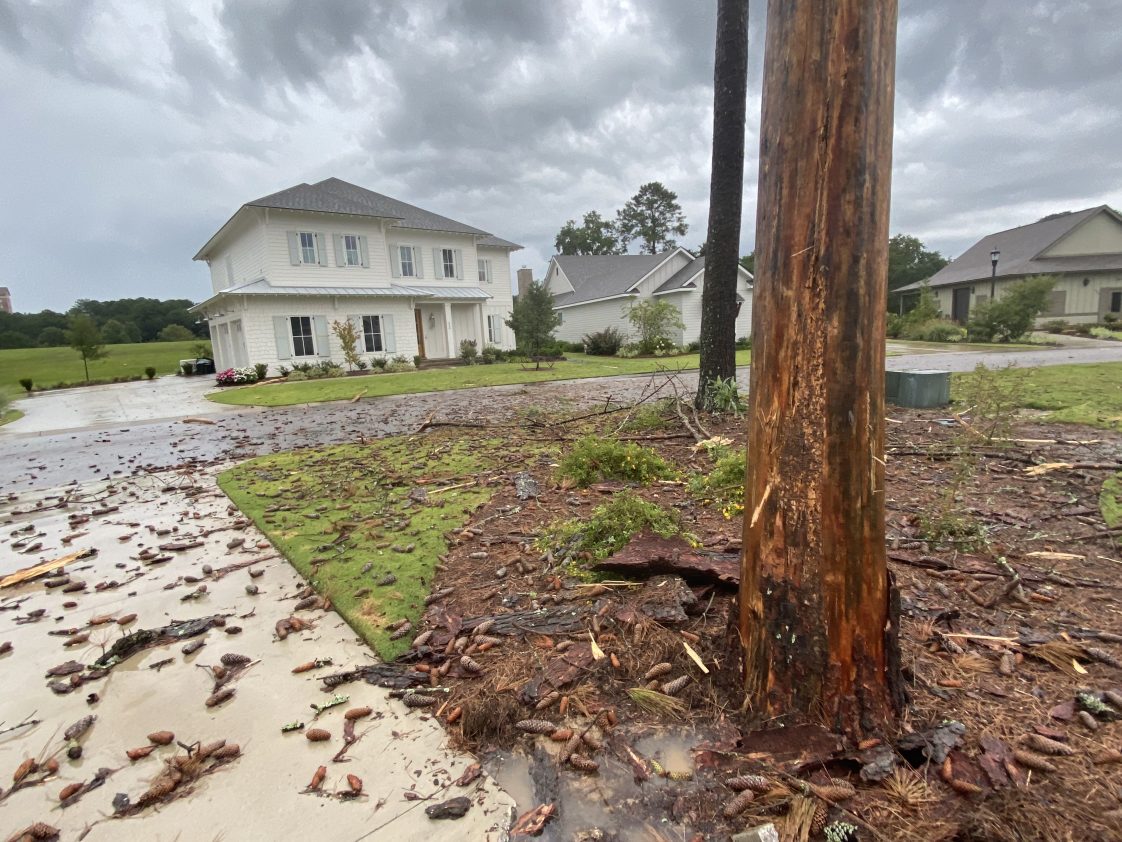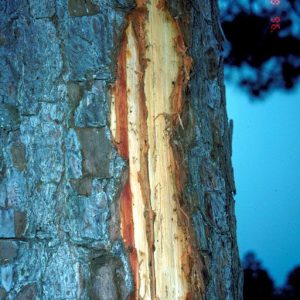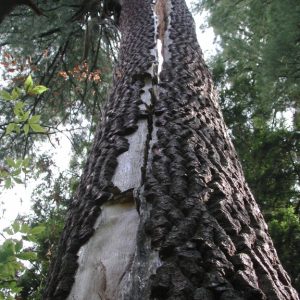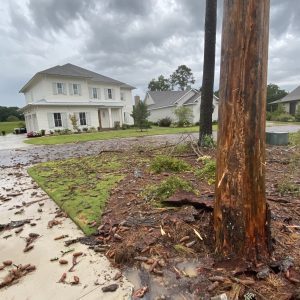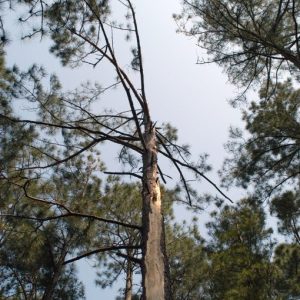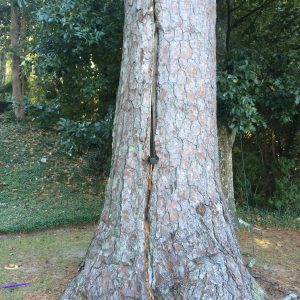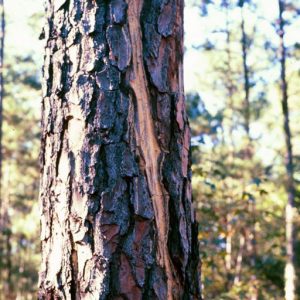Forestry

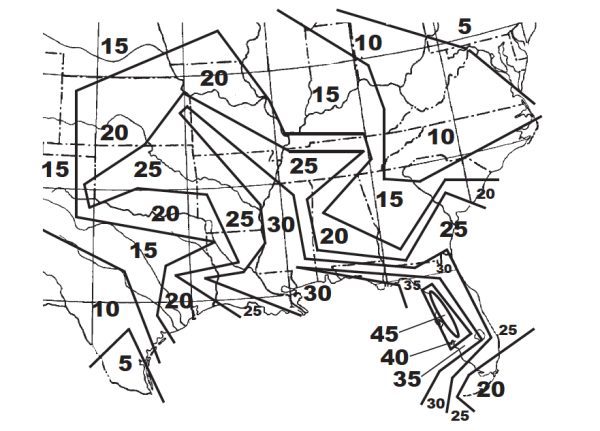
Figure 1. Average number of thunderstorms per year. South and central Alabama have the greatest number of storms per year. (Photo credit: Coder, Kim D. 2022. Lightning Strike Probability Risk. Warnell School of Forestry and Natural Resources. University of Georgia. WSFNR-22-04c, January, 2022.)
Most lightning strikes will likely occur in rural forests; some will happen in urban areas. Urban trees provide numerous benefits ranging from increasing property values, shading, screening neighbors, and providing wildlife habitat to simply enhancing neighborhood beauty. For these reasons, it is natural to protect and preserve lightning-struck trees. This document outlines the damage lightning causes to trees, when to remove trees, and management practices to reduce secondary pests and diseases caused by lightning strikes.
The average thunderstorm generates one lightning strike every 30 seconds during a 50-minute period. Alabama has an estimated 202 thunder days with nearly 1 million cloud-to-ground strikes. It is estimated that 6 percent of lightning strikes hit trees, or approximately 60,000 trees annually in the state. All of Alabama has an active thunderstorm season, but southern counties have more lightning strikes than northern counties (figure 1).
Why Does Lightning Strike Trees?
Lightning strikes occur when negative charges reach down from the base of storm clouds in long chains called stepped leaders. From the ground, there is a swell of positive charges drawn upward by the negative charges in chains called streamers (figure 2). Streamers are most prevalent on the tallest geographic features including mountains, buildings, boats, and trees. When the two paths meet, an electrical connection is made, and a rapid exchange of charges occurs, which generates light and heat, called lightning.
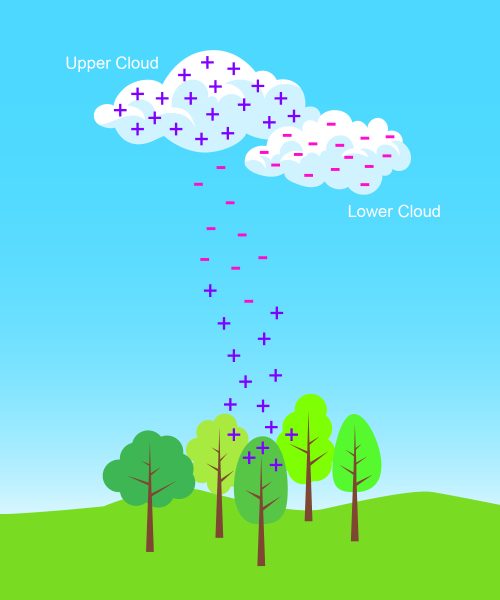
Figure 2. Lightning strikes occur when negative charges reach down from the base of storm clouds and a swell of positive charges comes up from the ground. When the two meet, a strike occurs. The tallest objects will have the greatest probability of being struck.
Lightning follows the path of least electrical resistance through the best conductor available. Wood is generally not a good conductor; however, the moisture in trees, in the form of water and sap, attracts lightning. Trees are often the tallest structures and decent conductors, so they are natural lightning rods. The tallest trees—single specimens in open fields or trees on hilltops—have the greatest potential for strikes. It is also important to consider site histories, as some areas are naturally more prone to lightning strikes than others. It is not uncommon to see multiple lightning-struck trees within small geographic areas.
What Damage Does Lightning Cause to Trees?
Lightning carries up to 100 million volts and reaches temperatures of 50,000 degrees F (27,760 degrees Celcius) or five times the temperature of the sun. In trees, these extreme temperatures boil water and sap generating steam and causing bark and wood fibers to explode. Lightning can strike a tree once or multiple times. It can travel from the top of the tree to its roots, skip down through branches, or only affect a portion of a trunk or branch. Lightning follows the best conductor within trees, possibly through the sap conducting phloem just under the bark or deeper within the water- conducting woody xylem.
Damage can vary from bark being blown out along a narrow strip (figure 3), exposing the interior wood, to more extreme cases (figure 4), debarking trees completely or causing deep cracks (figure 5). The immediate damage within trees are dead tissues along the path of the lightning strike and exposure of interior woody tissues to decay and insect attacks. There can also be invisible damage as the super-heated charge disrupts functions in larger portions of the trunk or roots. In these cases, trees might appear to die suddenly as leaves wilt and turn brown days after the event.
How to Manage Lightning-Struck Trees?
Managing lightning damage is a waiting game, allowing outward signs of interior damage to become visible in the crown. Before removing or even pruning the tree, wait several weeks for the damage to become evident. While you wait, preventative treatments are an option to ward off opportunistic insects, which can cause further damage. We advise managing lightning-struck trees with a multifaceted approach.
- Immediate assessment of the tree to determine the extent of damage and likelihood of survival.
- Preventative treatments for opportunistic pests.
- Cultural practices to help reduce tree stress.
- Figure 3. Lightning scars are highly variable. Narrower and shallower scars can be more survivable for trees. (Photo credit: G. Keith Douce, University of Georgia, Bugwood.org)
- Figure 4. When lightning scars extend into the woody tissues of the tree, future decay and the tree’s structural integrity will be a concern. (Photo credit: Joseph Obrien, USDA Forest Service, Bugwood.org)
- Figure 5. Lightning intensity can cause massive damage and kill trees outright. This tree was stripped of bark by lightning.
Tree Damage Assessment
No fixed guidelines are available for evaluating a tree’s likelihood of lightning strike survival. Instead, assess the extent of the outward damage and consider how trees will regrow around wounds. When assessing trees, it is important to consider the scope of the damage, tree health, and tree species. These factors affect each tree’s ability to grow around wounds and react to inevitable decay. For a list of tree species and tolerance to decay, see “Restoring Storm-Ravaged Trees: Step- by-Step Guide to Examining Your Tree for Safety” on the Alabama Extension website at www.aces.edu. The larger the wounds, the greater the potential for future decay and possible loss of structural integrity and safety concerns (table 1).
Table 1. Summary of Management Options
| Damage | Description | Management |
|---|---|---|
| Split tree (figure 4) | Lightning causes the tree trunk to totally or partially split apart. | Remove trees as structural integrity is lost and future decay will be cause further deterioration. |
| Deep crack on the main trunk (figure 7) | Cracks extending up and down the main trunk to a depth of one-third or more of the tree’s diameter signify lightning has entered the tree’s woody xylem and caused extensive damage. | Structural defects are likely. Future decay is a major concern. Remove the tree if near high-value targets. |
| Deep crack on large branches | Cracks extending to a depth of one-third or more of the diameter of the branch. | Structural defects likely. Reduction pruning to remove weight on limb or limb removal recommended. |
| More than one-third of bark was removed around the tree trunk’s circumference (figures 5 and 6) | Bark has been stripped from one-third or more of the tree’s circumference. This is a large wound exposing the interior wood to future decay. | Future decay is a significant concern. Remove the tree if the species is decay prone or has high-value targets within the dripline. |
| Less than one-third of the bark was removed from the tree’s circumference (figures 3 and 8) | Lightning scar strips bark from a narrow wound down the tree. | Monitor the tree for several weeks to see the extent of internal damage. Provide preventative pesticide treatments. |
Assess the width, depth, and vertical extent of the lightning damage within the canopy. Note that lightning can follow a direct path, spiral down the trunk, jump from branch to branch, or blow trees apart. If more than one-third of the canopy is blasted away with significant lightning scars (one-third or more of diameter), consider immediately removing the tree (figure 6). Similarly, if the tree has been totally or partially split, remove the tree (figure 4). In both these cases, the risk of failure will only increase over time as decay further weakens the tree.
Lightning scars with no bark for more than one-third the trunk diameter are likely to cause significant future decay, making them prone to structural problems and failure over time. Sometimes a tree will have multiple scars. If these scars are on the same side of the tree, the living tissue between the scars is likely dead, so consider that when estimating how much of the trunk is damaged.
Trees with cracks extending deep into the woody tissue will have decay issues and potential loss of structural integrity. If these trees are located near high-value targets, such as homes, busy streets, driveways, or frequently used portions of a landscape, they should be removed. Trees with more superficial lightning scars, less than one-third of the tree’s diameter, are good candidates for observation and preventative treatments.
- Figure 6. Lightning scars that extend more than one-third of the tree’s diameter will open the tree to significant decay in the future. (Photo credit: Erich G. Vallery, USDA Forest Service– SRS-4552, Bugwood.org)
- Figure 7. Lightning scars can cause deep cracks in a tree, which will often require removal of the tree.
- Figure 8. Narrow and shallow strikes are often survivable for many trees. Preventative pesticide treatments might be needed for opportunistic invaders. (Photo credit: Stephen F. Austin State University, Bugwood.org)
Bark Tracing
In some cases, lightning strikes can leave jagged, irregular wounds on a tree. Bark tracing is a technique that removes the loose and jagged bark on the edges of the scar. If the tree is a candidate for preservation, use a sharp knife to carefully remove loose bark and broken or jagged wood from the wound. Take care not to enlarge the wound, which would take the tree longer to seal. Bark tracing should only be done if needed and as high up on the trunk as feasible.
Preventative Treatments for Insects

Figure 9. In pines, Ips pine beetle attacks are common
in days or weeks after lightning strikes. These pests can quickly weaken and kill trees. (Photo credit: G. Keith Douce, University of Georgia, Bugwood.org)
Lightning strikes strip away the bark, which protects the interior woody tissues from opportunistic decay and insects. Strikes can also damage water- and sap-conducting vessels, pushing trees into drought- like stress. Damaged and stressed trees emit volatile compounds that attract insects. As a result, many lightning-struck trees often suffer from secondary pests that can further weaken and kill them.
In pines, several pine beetle species (Ips, southern pine beetle, and black turpentine beetle) are likely to be a problem (figure 9). A host of ambrosia beetle species can be problematic in hardwood trees (figure 10). Both groups of insects bore into weakened trees and inoculate them with fungus that plug up the water-conducting vessels in the trees. If the beetle populations are allowed to grow and spread outside the lightning scar to the entire circumference of the tree, death is likely.
Unfortunately, once either of these beetle groups enter trees, no labeled products can control the pests. Instead, preventative treatments must be applied to kill beetles as they attempt to bore into trees. As a result, the timeliness of the application is critical as beetles can begin to infest trees within days. Make applications as soon as possible—the next day or within days at the latest to ensure that trees are protected. There is some controversy about the effectiveness of preventative insecticide treatments as the full extent of lightning damage cannot be fully understood; however, in some cases, it could be advantageous.

Figure 10. In hardwoods, look for sawdust at the base of the tree or in the bark crevices. Ambrosia beetles can also leave toothpick like fras tubs. These pests can introduce fungi and cause trees to decline and die. (Photo credit: James Johnson, Georgia Forestry Commission, Bugwood.org).
There are both contact insecticides, including Bifenthrin and Permethrin that are sprayed onto tree trunks, and injectable systemic products, such as Emamectin Benzoate that require a professional arborist to inject into trees (table 2). Spray contact pesticides directly onto the lightning scar and the entire trunk. A possible exception would be large trees with small lightning scars, which would require spraying only the area around the scars. Spray the entire trunk for smaller trees under 28 inches in diameter at breast height. Apply the insecticide till the bark is wet.
The limitations and concerns with the application of contact pesticides are three-fold:
- The entire trunk should be treated, which might require equipment to reach the upper portions of the tree.
- Reapplication may be required every few weeks, within label guidelines, as rain washes away the treatment.
- The product can affect nontarget species through drift or the applicator.
These insecticides are readily available. Contact insecticides should be reapplied for 1 or 2 months after lightning strikes. Injectable systemic products provide more long-term protection, sometimes up to 2 years, and will protect the entire tree (table 2). Systemic products rely on the water- and sap-conducting vessels to move the insecticide throughout the canopy, which can provide excellent long-term protection. The limitations to these products are as follows:
- These products are more expensive and require hiring professionals to apply.
- The required drilling causes further damage to the tree.
- The tree must be actively moving water for the product to be fully effective. If the tree has substantial lightning damage and is wilting, the products might not work.
Regardless of the product you choose, follow the label instructions and wear the appropriate personal protective equipment.
Table 2. Pesticide Applications Summary
| Tree Species | Application Method | Products | Application Notes | Cautions |
|---|---|---|---|---|
| Pines | Contact pesticides | Bifenthrin Permethrin | Spray the trunk until wet from ground to mid-canopy. | Contact pesticides are often impractical because spraying tall trees is difficult, and pesticide drift is a concern. Requires reapplication every few weeks. |
| Pines | Injection | Emamectin Benzoate | Holes are drilled around the tree’s base, and insecticide is macro-infused into the tree. | Requires hiring an arborist, which can be costly. Provides up to 2 years of protection. Spray the lightning scar with a contact pesticide because the damaged wood will unlikely receive the injected product. |
| Hardwoods | Contact pesticides | Bifenthrin Permethrin | Spray the lightning scar and 1 foot to either side until wet. Spray as much of the lightning scar as possible. | Ideally, the entire lightning scar is sprayed; however, this may not be practical for taller trees as drift is a concern. Instead spray as much as possible and at least 1 foot to either side of the lightning scar. |
| Hardwoods | Injection | Emamectin Benzoate | Holes are drilled around the tree’s base, and insecticide is macro- infused into the tree. | Requires hiring an arborist, which can be costly. Provides up to 2 years of protection. Spray the lightning scar with a contact pesticide, as the damaged wood is unlikely to receive the injected pesticide. |
Irrigation
Because the roots and water-conducting vessels might have been damaged, watering can help the injured tree, particularly in dry periods. Apply a deep watering by ensuring that the top 6 to 9 inches of soil are moist. Limit watering to one or two times per week, and be sure that the water is applied to the tree’s entire root zone or as much of the drip line as possible.
Lightning Protection Systems for Trees
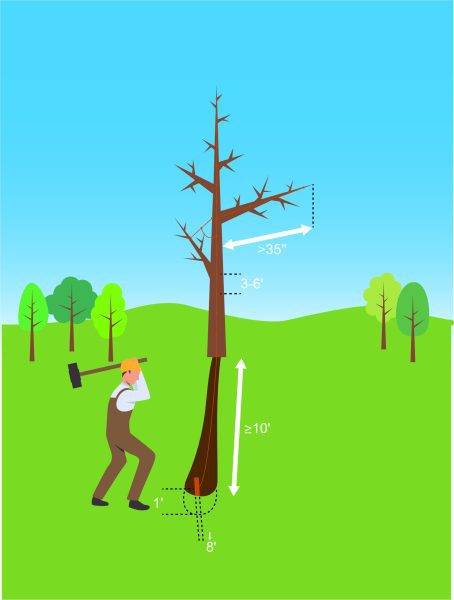
Figure 11. Lightning protection systems for trees provide an exterior path for lightning to reach the ground outside the tree. The tree size and structure determine how much equipment is needed for the protection system.
Because trees are often the tallest structures in the average landscape and are prone to lightning strikes, arboriculture has developed lighting protection systems for trees. These are designed to provide an exterior path for lightning to travel to the ground outside of the tree (figure 11). They are remarkably similar to home lightning protection and are made entirely of copper and brass.
A typical lightning protection system will consist of the following:
- One to five air terminals
- Conducting cabling (usually braided copper cable)
- Brass attachments every 3 to 6 feet to keep the cabling and points attached to the tree
- Ground terminal (a copper rod pounded into the soil)
The size of the tree and its structure determine how much equipment is needed. For example, a single- trunked tree less than 36 inches in diameter at breast height and with a canopy less than 35 feet in diameter will require perhaps one air terminal and a single cable and ground rod. A tree with a forked crown will need a cable and air terminal for each fork.
A tree with a crown wider than 35 feet will require additional air terminals to connect to the main conductor. A large tree will require multiple air terminals, cables, and ground rods.
These systems are costly, as they are constructed from copper and require a well-trained tree care specialist to install correctly. Because of this, tree lightning protection systems are usually recommended only for high-value trees, trees with historical significance, or trees close to people in areas with high lightning strike potential.
As with all highly skilled tree work, we recommend ISA Certified Arborists with training in the craft to install a protection system.
References
- Coder, Kim D. 2022. Lightning Strike Probability Risk. Warnell School of Forestry and Natural Resources. University of Georgia. WSFNR-22-04c, January, 2022.
- Uman, M.A. 2008. The Art & Science of Lightning Protection. Cambridge University Press, Cambridge, UK. Pp.240.
 Arnold Brodbeck, Extension Specialist, Community Forestry and Arboriculture; Jack Rowe, Regional Extension Agent, Forestry, Wildlife, and Natural Resources; and Jim Jacobi, Extension Specialist, Commercial Horticulture and Home Grounds, Gardens, and Home Pests, all with Auburn University
Arnold Brodbeck, Extension Specialist, Community Forestry and Arboriculture; Jack Rowe, Regional Extension Agent, Forestry, Wildlife, and Natural Resources; and Jim Jacobi, Extension Specialist, Commercial Horticulture and Home Grounds, Gardens, and Home Pests, all with Auburn University
New May 2023, Caring for Lightning-Struck Trees, FOR-2134

